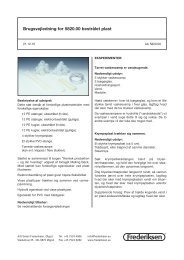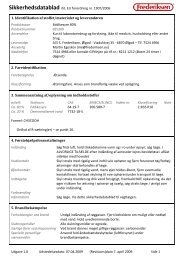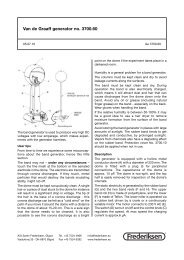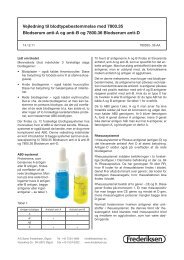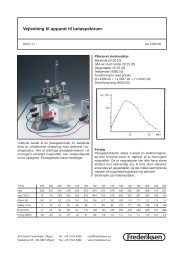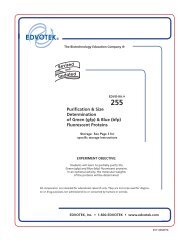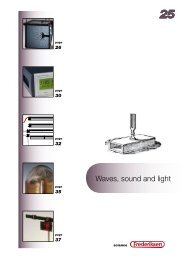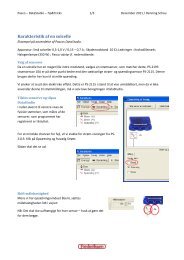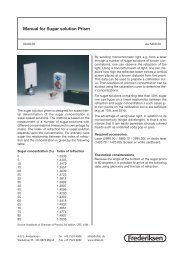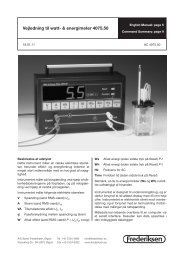grundskabelon_ AA - Frederiksen
grundskabelon_ AA - Frederiksen
grundskabelon_ AA - Frederiksen
Create successful ePaper yourself
Turn your PDF publications into a flip-book with our unique Google optimized e-Paper software.
Van de Graaff generator no. 3700.60<br />
03.01.11 Ae 3700.60<br />
point on the dome if the experiment takes place in a<br />
darkened room.<br />
The band generator is used to produce very high DC<br />
voltages with low amperage, which makes experiments<br />
with the generator harmless.<br />
User tips<br />
From time to time we experience some misconceptions<br />
about the band generator, hence this little<br />
section.<br />
The band may not – under any circumstances –<br />
touch the fine mesh at the bottom or the serrated<br />
electrode in the dome. The electrons are transmitted<br />
through corona discharges. If they touch, metal<br />
particles that would destroy the bands insulating<br />
ability, might rub off.<br />
The dome must be kept scrupulously clean. A single<br />
hair or a piece of dust stuck to the dome for instance<br />
will result in a significant drop in voltage. The tip of<br />
the hair is the base of a corona discharge - this<br />
corona discharge can be felt as a "cold wind" on the<br />
palm if you move it around the dome with a distance<br />
to the dome of about 15-20 cm. This is a sure sign<br />
that the dome needs to be cleaned. It is also<br />
possible to see the corona discharge as a bright<br />
Humidity is a general problem for a band generator.<br />
The columns must be kept clean and dry to avoid<br />
leakage currents along the surfaces.<br />
The band must be kept clean and dry. During<br />
operation the band is also electrically charged,<br />
which means it will attract dust and hair that can<br />
cause discharges from the dome down onto the<br />
band. Avoid any oil or grease (including natural<br />
finger grease) on the band - especially on the back.<br />
Wear gloves when handling the band.<br />
If the relative humidity is between 50-100% it may<br />
be a good idea to use a hair dryer to remove<br />
moisture formation from the surface of the band<br />
generator.<br />
Avoid storing the band generator in places with large<br />
amounts of sunlight. The rubber band tends to get<br />
degraded and conductive, by prolonged sunlight.<br />
Vapors from chemicals also have a degrading effect<br />
on the rubber band. Protection cover No. 3700.10<br />
should be applied when not in use.<br />
Description<br />
The generator is equipped with a hollow metal<br />
conductor dome (A) with a diameter of 220 mm. The<br />
dome is fitted with a plug (I) for peripheral<br />
connections. The capacitance of the dome is<br />
approx. 15 pF. The dome is two-split, and the top<br />
half is easily removed for inspection of the dome’s<br />
internals.<br />
The static electricity is generated by the rubber band<br />
(G) and the two band reels (F and H). The upper<br />
band roll (H) is made of polyethylene, and the lower<br />
(F) is made of Teflon. The lower roller is operated via<br />
a rubber belt driven by a crank or a continuously<br />
variable motor. The motor connects to 230 V AC (E).<br />
The switch (D) turns it on/off and the control knob (C)<br />
regulates the speed. At max speed the charging<br />
current is approx.6 µA.<br />
A/S Søren <strong>Frederiksen</strong>, Ølgod Tel. +45 7524 4966 info@frederiksen.eu<br />
Viaduktvej 35 · DK-6870 Ølgod Fax +45 7524 6282 www.frederiksen.eu<br />
®
K<br />
If you want to drive the<br />
belt manually, the drive<br />
belt (K) is moved<br />
from the pulley on the<br />
motor, to the crank<br />
pulley instead.<br />
The generator is fitted<br />
with a plug to be<br />
used for grounding or<br />
connection for a rod mounted conductor sphere<br />
(No. 3705.00).<br />
Maintenance<br />
The dome (A) and band reels (H + F) is cleaned with<br />
a clean cloth or damp chamois. If very dirty, benzine<br />
(petroleum ether) can be used as well.<br />
The columns (B) are also cleaned with a clean cloth<br />
or damp chamois. Hardened stains can be removed<br />
gently with isopropyl alcohol.<br />
The band is cleaned with benzine. Be careful to get<br />
the dirt and grease removed properly, not just smeared.<br />
Removing the band<br />
1. Remove the drive belt from the motor, loosen the<br />
hexagon-head screw (F) in the lower band roll and<br />
pull the shaft out of the bearings. The belt pulley<br />
can now be removed.<br />
2. Remove the dome's upper half.<br />
3. Remove the serrated electrode by unscrewing the<br />
two chromed thumbscrews (J). The upper band<br />
roll can now be lifted clear.<br />
Assembly<br />
1. Start by mounting the upper band roll along with<br />
the band.<br />
2. Then tighten the band with the lower roller as it is<br />
being set in place. Note that the shiny side of the<br />
band should face toward the rollers!<br />
3. The serrated electrode and upper part of the<br />
dome can now be mounted.<br />
Technical data<br />
Dome diameter: 220 mm.<br />
Spark Length: 80-100 mm.<br />
Operating voltage: 230 volts AC.<br />
Total Height: 560 mm.<br />
Width:<br />
195 mm.<br />
Depth:<br />
195 mm.<br />
Spare parts<br />
No. 3700.01 Replacement Band.<br />
No. 3700.02 Drive belt for band generator.<br />
No. 8870.00 Talc.<br />
No. 3700.10 Protection cover for band generator.<br />
Optional accessories<br />
No. 3705.00 Conductor sphere on rod, Ø 100 mm<br />
No. 0006.00 Retort Stand Base, tripod.<br />
No. 4430.00 Electric whirl.<br />
When using this Van de Graaff generator electromagnetic<br />
signals are created, which can disturb<br />
other electronic equipment, e.g. gauges, communication<br />
equipment and computers. Apply only the<br />
Van de Graaff generator in places, where such<br />
equipment will not be disturbed.<br />
®



